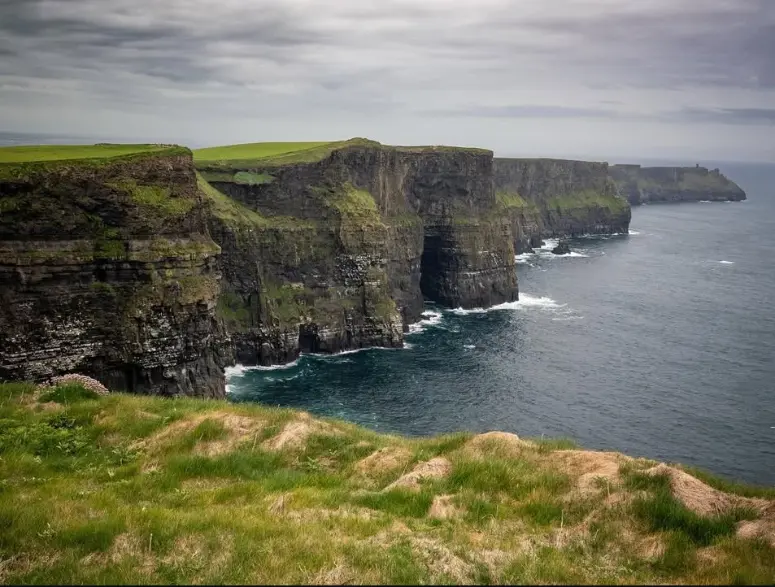I have lost count of how many times I have been to Ireland. Some trips were for work, some were for romantic weekends with my partner, and some… well, let’s just say they were family “packing light” disasters that could have been a Netflix comedy.
But here is the one truth Ireland has drilled into me: NEVER TRUST THE WEATHER. Not for a second.
This is the land of rolling green hills, dramatic coastlines, and locals who make you feel like an old friend within five minutes. But underneath all that charm? The weather mood swings like you would not believe. I have stood in bright sunshine, been caught in sideways rain, and felt hail bounce off my head, all before lunch. And no, this was not some rare event. This was just a normal Tuesday in Ireland.
So, if you are here looking for the ultimate Ireland travel clothing tips, you are in exactly the right spot. I have frozen solid in July, sweated through a December pub crawl, and once sprinted after my umbrella down Grafton Street, only to give up and let it go.
After enough trips to fill a pub storybook, I have finally cracked the code. What to wear & carry in Ireland is not just about outfits, it is your go-to packing list for Ireland travel, so that you can roll with every single curveball the Irish weather will throw your way and still look like you meant to dress that way. Keep reading to learn more!
Golden Rules for What to Wear in Ireland
Before we get into the seasons, here are the commandments you must obey that are hard-earned from personal experience.
1. Pack for All Seasons, ALWAYS
It doesn’t matter if you’re landing in June or December. In Ireland, “season” is just a loose suggestion. Even in July, I’ve needed a warm jumper. Even in February, I’ve seen people in T-shirts.
2. Where You’re From Changes Everything
If you’re from Canada, Irish winters might feel like a mild autumn. But if you’re from Singapore, that damp 8°C breeze will slice through you like a pint of Guinness at 10 a.m. So, know your limits.
3. Layers are Your Best Friend
This isn’t just about warmth, it’s about flexibility. You need to be able to strip down when the sun decides to play nice, and bundle up when the Atlantic wind changes its mind (which it will).
The Seasonal Breakdown & the Lessons I Learned the Hard Way
Spring (March–May): The Season That Keeps You Guessing
Spring in Ireland is a bit like going on a first date with someone lovely but wildly unpredictable. You start thinking, “This is going well,” and ten minutes later, you are standing in a hail shower, wondering what just happened. One minute, daffodils are blooming and lambs are bouncing in green fields. Next, a wind so sharp hits your face, you are sure it came straight from the Arctic.
I learned fast that what to wear in Ireland in spring is not what you would wear anywhere else. One April, determined to “pack light,” I brought a thin trench coat and, heaven help me, no gloves. I told myself I was being chic. In reality, I spent most of the trip hugging takeaway coffees for warmth. By day three, my fingers were ready to quit on me.

Now, I dress as if I might see sunshine, rain, and a mini-storm all before lunch. Layering clothes for the Ireland trip has become my secret weapon. And if you visit during St. Patrick’s Day, expect double the chaos because of unpredictable skies, crowded streets, and a good chance of Guinness splashing onto your coat before nightfall. Consider it part of the experience.
Summer (June–August): When Ireland Pretends to Be the Mediterranean
I have a soft spot for Irish summers. There is something magical about watching locals rush to the beach the moment the mercury dares to touch 20°C, as if the whole country has been whisked away to Spain overnight. But do not be fooled. This is not a Mediterranean summer. It is an Irish summer, which means what to wear in Ireland in summer is about more than sandals and sundresses.
One July, my partner and I booked a romantic weekend in Galway. The forecast promised clear skies. I believed it. I packed light dresses, strappy sandals, and a big dose of optimism. What I got was 14°C, sideways rain, and the damp misery of a maxi dress plastered to my legs. We spent the weekend darting between cafés, sipping hot chocolate instead of wine by the sea. Lesson learned: trust Irish locals when they say “bring a jacket” and never trust a July forecast.

Now, when summer comes around, I still pack the dresses and sandals, but there is always a light rain jacket tucked into my bag and the best shoes for walking in Ireland to keep my feet dry if the weather turns. The sun here is glorious but fleeting. Enjoy it to the fullest, but be ready for it to vanish without warning.
Autumn (September–November: My Favourite, and the One That Can Trip You Up
If I could choose just one season to be in Ireland, it would be autumn. There is a richness to it that feels almost cinematic. It is postcard-perfect.
But what to wear in Ireland in autumn can make or break your trip. The romance of the season hides a bite, and the winds from the Atlantic can cut straight through you. I learned this the hard way when I hiked the Cliffs of Moher in October wearing my “fashionable” leather boots. They looked great until I realised they had zero grip. The rest of the hike was less about soaking in the view and more about avoiding a dramatic slide toward the ocean.

Now, I lean into the cosiness and practicality: chunky wool sweaters (bonus points for a real Aran knit), cardigans over long-sleeved tops, and waterproof boots with enough grip for muddy trails. I never forget a windproof coat, and I always think in layers. Mentioning it again because layering clothes for an Ireland trip is the secret to staying comfortable when the weather flips between crisp sunshine and bone-chilling gusts. The views are worth it, but the wind is not here to play..
Winter (December–February: Damp Cold Is Still Cold
Irish winters aren’t dramatic, snow-covered affairs. They’re quiet, grey, and relentlessly damp. The temperature rarely drops into the negatives, but don’t let that fool you. The cold here is sneaky. It seeps in slowly until you suddenly realise your bones feel cold.
One Christmas in Cork, I made the rookie mistake of thinking 8°C sounded perfectly manageable. I wore my chic city coat and ankle boots, imagining a brisk but pleasant wander around the town’s outdoor market. Two hours later, I couldn’t feel my toes. By the time I got back indoors, I was on the verge of bargaining with the universe for a hot water bottle.

Now I don’t take chances. I pack as if I’m bracing for a head-on battle with winter itself — knee-length waterproof coat, thick jeans or thermal leggings, wool sweaters, and sturdy waterproof boots. Hats, scarves, and gloves aren’t optional extras here; they’re survival tools.
Packing Strategy on What to Wear & Carry in Ireland: My Hard-Won Master Plan
After years of stuffing my suitcase with all the wrong things, wearing the same jumper in every holiday photo, and spending far too much money buying “emergency clothes” in Irish shops, I’ve finally cracked the code.
The secret? Accept that Ireland doesn’t care about your weather expectations. You can study the forecast all you want, but it’s just a polite suggestion, not a promise.
The first step is knowing the seasons, yes, but also knowing that you’ll probably meet all four of them in one week. I’ve had days in Dublin where I started out in a T-shirt, ended up wearing my winter coat, and then found myself back in a café in just a cardigan by evening. That’s why I always build my packing list around versatility.
There are, of course, the non-negotiables: passport, charger, Type G adapter, toiletries, medicine, and a reusable water bottle. But the trick is in the clothes. I plan outfits for activities, not for the calendar. Hiking boots for those muddy trails in Wicklow, comfortable walking shoes for city exploring, and yes, the swimwear. Not because the Atlantic is warm (it’s not), but because you might find yourself in a heated hotel pool or a spa overlooking the sea.
I’ve also learned the beauty of the “casual-smart” approach. In Ireland, jeans and a nice top will take you almost anywhere, from a casual pub lunch to a last-minute dinner in a nicer restaurant. I always keep one “dressier” outfit tucked away for those spontaneous evenings that somehow end with wine in a candlelit corner of a bistro.
And no matter how much of a minimalist I’m trying to be, I always leave a little space in my suitcase. Because somewhere along the trip, I’ll buy something like a cosy Aran sweater, a scarf from a tiny village shop, maybe even a pair of boots after I inevitably ruin my own in a puddle.
The Essentials I Won’t Travel Without
There are certain items I could leave at home in theory, but in practice? I’d feel naked without them. Top of the list: a windproof rain jacket. In summer, it’s lightweight and easy to fold into my day bag. In winter, it’s insulated and hooded, ready for whatever sideways drizzle the day throws at me.
Jeans are my trusty constant, as it is sturdy enough for walks along a cliff path, smart enough for city cafés. I pack a handful of layering basics: two light tops, a warm cardigan, and a wool jumper for when the wind feels personal.
Shoes are where I’ve made my biggest mistakes in the past (leather boots with no grip on a muddy path). Now it’s trainers in summer, waterproof boots in autumn and winter, and something comfortable but smart for evenings out. A scarf or shawl is my wildcard item as it is an instant lifesaver if the temperature dips.
My small backpack is a bit of a shapeshifter. In leather, it doubles as a day bag and an evening bag. And I always pack seasonal extras like hats and gloves in winter, longer shorts or breezy skirts in summer. They don’t take up much space, and they’ve saved me more than once.
What I’ve Learned Not to Pack
There is one thing I will never pack for Ireland again: an umbrella.
It might feel wrong, but Irish rain does not fall straight down. It comes at you sideways, swirling in gusts that turn umbrellas into broken, inside-out sculptures in minutes. A hooded rain jacket is the smarter choice. It is one of the top travel essentials for women and men, keeping you dry without the battle. If you are buying waterproof jackets for Ireland travel, choose one with deep pockets, a strong zipper, and a good hood. It will save you from many soaking, windblown surprises.
What You’ll Actually See in Ireland on Fashion and Style
I love people-watching in Ireland. In Dublin, there is a casual but edgy vibe, blending European polish with hints of London and Copenhagen cool. In rural towns, evenings can feel surprisingly glamorous. I have seen tiny village pubs where women arrived in cocktail dresses and heels, and men in crisp button-down shirts, all for a simple Saturday pint.
For everyday wear, jeans are your safest bet. In upmarket restaurants, go for smart casual, polished but not overly formal. In cosy pubs, a chunky jumper and jeans will make you feel perfectly at home.
The beauty of Irish style is that it is never about perfection. It is about comfort with personality. Ireland travel clothing tips often come down to one thing: dress for yourself, not the weather forecast. Carry a scarf to your packing list for Ireland travel and you will fit right in, pint in hand.
Final Thoughts from Someone Who’s Been There and Been Soaked
Ireland is one of the most beautiful and welcoming countries I have ever explored, but it demands respect from your wardrobe. I have been caught out enough times to know that packing for Ireland is not just about style; it is about survival. The right layers mean you can enjoy that cliffside view without chattering teeth. The right shoes mean you can wander cobbled streets without slipping.
Once you understand the Irish weather code, you will understand what to wear and carry and packing becomes easy. Ireland travel essentials for women and men alike start with smart choices: waterproof gear, sturdy shoes, and versatile pieces.
Layering clothes for an Ireland trip will keep you ready for sunshine, mist, or a surprise storm. Does not matter if you are here for work, romance, or wrangling a family adventure. Pack smart, embrace the unpredictability, and remember: in Ireland, there is no bad weather, only the wrong clothes!